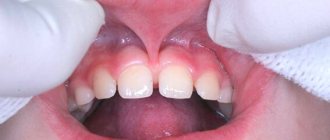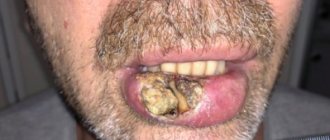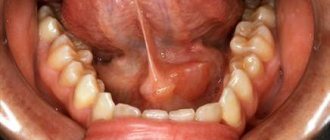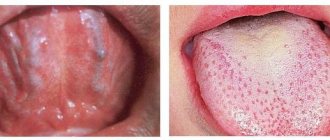Tongue cancer is a fairly rare disease, but despite this, more and more cases of this pathology are registered every year. The most important thing is to pay attention to the early signs when a tumor appears; besides, it is quite difficult to miss. It should be noted that most often males suffer from tongue cancer, while women are least affected by this disease. What are the symptoms of tongue cancer?
Causes of tongue cancer
The symptoms of tongue cancer cannot be confused with anything!
Tongue cancer, like any other form of malignant tumor, appears for a reason. Its appearance is preceded by many factors that provoke cell mutation. The main causes of tongue cancer include:
- Excessive smoking. But in some cases, even smokers with little experience may develop a tumor. This is due to the individual characteristics of the body and the structure of the mucous membrane
- Chewing nicotine gum, which is used by people if they want to get rid of a bad habit.
- Chewing tobacco, which irritates and damages the mucous membranes
- Excessive consumption of alcoholic beverages
- Heredity. Many people know that if someone in their family had one or another cancer disease, then their descendants are at risk
- Serious diseases that can provoke a decrease in the body’s defenses, that is, immunity
- Papilloma virus. Scientists attribute an increase in the number of cases of patients with tongue cancer to this reason. This is because people are engaging in oral sex more often. And, as you know, papilloma is transmitted both sexually and oral
- Inflammation of the gums that remains untreated for a long period of time
- Poor dental condition
Despite the fact that almost everyone knows about the main causes of tongue cancer, few people pay attention to them. And therefore, every year the number of people with this disease, which is not so easy to treat, is growing.
Polyps on the tongue: causes, symptoms and treatment
Papillomas and polyps are similar in nature, but have fundamentally different pathologies:
- A polyp is a benign tumor without critical health consequences. With timely treatment, it has little chance of developing into a malignant tumor and cancer. The reason for the growth of polyps is unknown to modern medicine.
- Papilloma is necessarily the result of a viral infection through contact of any kind (except through the air) with a cross-infected person.
The big difference in defining a neoplasm is its location. The polyp grows on the mucous membranes and is difficult to detect on its own. Papilloma forms on the external tissue and is easy to recognize.
Diagnostic features
A polyp in the throat is not cancer, and in most cases it is not even a harbinger of cancer. However, doctors recommend removing pathological lesions before the first symptoms appear.
The mechanism of formation of laryngeal polyps is similar to the formation of neoplasia of any other localization - atrophic changes in the mucous membranes due to a number of multiple factors (chaotic compensatory division of cells of mucosal structures).
Identify the following causes of pathological growth of the mucous membrane:
- Heavy inheritance;
- Professional activities (singing, talking, teaching);
- Bad habits (tobacco smoke, abuse of coffee, alcoholic beverages); Unfavorable working conditions (dusty workshops, chemical production, coal mines or cement plants);
- Thyroid diseases;
- Tumors in the throat of a different origin;
- Immunodeficiency;
- General respiratory diseases;
- Chronic bronchitis, laryngotrachitis.
Due to the polyetiology of polyps in the throat, neoplasms can occur in patients of any gender and age.
The potential cancer risk group includes patients whose genetic history includes cases of throat cancer in close relatives.
In the vast majority of cases, laryngeal polyps acquire neoplasms that are a consequence or complication of chronic diseases of the larynx and bronchial tree.
Is it dangerous?
Polyps themselves do not pose an immediate threat of cancer, but can cause a number of serious consequences with intensive spread, growth and changes in morphological structure:
- chronic angina, bronchitis, persistent cough;
- irreversible voice changes;
- purulent lesions in the throat;
- atrophy of the pharyngeal mucosa and decreased sensitivity.
The growth of polyps occurs slowly, but under the influence of certain factors, uncontrolled growth and an increase in the number of pathological foci are possible.
Laryngeal polyps are an area of study in otolaryngology and oncology. Suspicion of the presence of polypous lesions in the pharynx arises during a typical examination of the patient’s pharynx, as well as during examination of the pharynx with special instruments.
The main research method is endoscopic laryngoscopy, but mirror laryngoscopy is still used in municipal medical institutions.
Laryngoscopy allows:
- assess the condition of the mucous membranes deep inside the larynx, the structure of the polypous lesion;
- if malignant cells are suspected, perform a biopsy for subsequent endoscopic examination.
Histology is often prescribed after polyp removal.
Precancerous conditions
We should also talk about those diseases that are classified as precancerous conditions. It is they who need to pay more attention and treatment, since any factor can provoke the degeneration of simple cells into cancerous ones. Such diseases include:
- Leukoplakia. This is keratinization of the mucous membrane in the mouth, most often a red stripe appears on the lips. The main reason for the appearance of this disease is a decrease in the stability of the mucous membrane in the gastrointestinal tract, which leads to the penetration of harmful microbes and viruses into it, which can provoke cell mutation
- Papilloma. This is a benign formation, which consists of papillary growths of connective tissue. In themselves, such formations are painless, but they pose a great danger associated with the possibility of the tumor degenerating from benign to malignant
- Ulcer. It often happens that a person damages the oral mucosa. This can occur as a result of biting the cheek, tongue, cut, or thermal burn. In the event that no antibacterial treatment is carried out, the likelihood of ulcers on the mucous membrane increases, and as a result, in the future, the formation of cancer cells
- Glossitis. This is a very rare disease, but still encountered in medical practice, which is characterized by pain in the tongue, as well as increased salivation.
- Bowen's disease. This disease is characterized by the appearance of a small spot on the tongue, which has a rough surface. Over time, erosion may appear on it
If a patient is diagnosed with one of the above diseases, then close attention is paid to its course, as well as treatment. Due to the fact that some of these diseases cannot be completely cured, a person is recommended to visit a specialist every six months or year for a full examination and examination in order to control the situation.
Symptoms of tongue cancer
Papillomas can cause cancer
Tongue cancer is one of the diseases whose symptoms are so vivid that they force a person to independently seek medical help from a specialist. The main symptoms of tongue cancer include:
- The appearance of plaque or spots on the tongue itself. The spots and amount of plaque may vary for each person, as it depends on what stage of cancer, where in the tongue it is located, etc.
- The appearance of ulcers on the tongue
- The appearance of a small lump on the surface of the tongue, which indicates that the person has the first stage of tongue cancer
- Painful sensations that primarily appear at the site of the tumor. But sometimes the pain can radiate to the jaw, throat, ear or nose. Very often, pain intensifies when a person eats food, especially solid food.
- Bad breath, which occurs due to the presence of cancer cells in the mouth
- Inflammation of nearby lymph nodes. One of the most obvious signs of any cancer is enlarged lymph nodes. This pathology is characterized by enlargement of the cervical and submandibular lymph nodes. Separately, it is worth saying that not one node will be enlarged, but the entire group at once, which should alert any person
- Increased production of saliva, which has nothing to do with food intake or hunger
Depending on where the tumor is located on the tongue, certain symptoms will be more pronounced, or, conversely, more blurred.
It is customary to distinguish several options for the location of the tumor:
- At the root of the tongue
- On the side surface. Most cases occur in this location of the tumor
- On the bottom surface
- On the top surface
The symptoms of tongue cancer cannot be confused with almost anything. In addition, discomfort in this area is noticed almost immediately, since the resulting tumor interferes with normal eating, and sometimes can even interfere with conversation.
Tongue cancer - treatment in Moscow
In the presence of tongue cancer, timely diagnosis of the disease and treatment started as early as possible are necessary, which will give the patient a chance for a full recovery. High-quality diagnosis and effective treatment of tongue cancer in Moscow at the oncology clinic will provide the patient with the opportunity to live a full life. The clinic has high-tech equipment and a staff of qualified specialists at its disposal. Rehabilitation is available to patients at the oncology clinic.
The price of treatment for tongue cancer at the oncology clinic of the Yusupov Hospital in Moscow varies from 5 to 20 thousand rubles, depending on the complexity of the disease.
Periods of development of cancerous tumors
Tongue cancer develops very rapidly. That is why it is customary to distinguish several forms and periods, each of which will be characterized by its own symptoms of manifestation. It is customary to distinguish three periods of tongue tumor development:
- Elementary. At this stage, the person begins to notice that a seal has appeared on the tongue, which causes him discomfort. After a short period of time, the tissue in this place becomes more and more dense, and white spots also appear. On top of everything else, there are also pain sensations that spread not only to the site of the tumor, but can also radiate to the throat, nose or ears. True, some patients associate pain with caries or sore throat. In the initial period, three forms of tumor can be distinguished, differing in anatomical characteristics:
- Ulcerative. A lump appears that eventually develops into an ulcer
- Knotty. The seal that has appeared has a whitish tint and is also very dense to the touch. In addition, there are clear boundaries of education
- Papillary. Growths appear that are very similar to papillomas. Only if the papilloma itself is not hard, then the papillary tumor is very hard
- Developed. During this period, all symptoms begin to worsen, and the person suffers from severe pain. In most cases, the pain becomes so severe that even painkillers do not help the patient. In addition, the pain is localized not only in the tongue, but also spreads to the throat.
Also, during an acute pain attack it radiates to the ear or nose. It is during this period that bad breath appears, which is caused by the breakdown of cancer cells. In the developed period, it is customary to distinguish two forms of tumor:
- Exophytic. Ulcers increase in size slightly
- Endophytic. The ulcers deepen and become very large
- Neglect. During this period, the cancer spreads so quickly that the tissue begins to break down, the tumor increases in size, and the symptoms become very vivid.
As mentioned above, each period is characterized by its own course and symptoms. They manifest themselves most clearly in the second period, and already force any person, even those who do not take them seriously, to consult a specialist to find out the cause.
Symptoms of benign tumors of the tongue
Tumors of the tongue, which are small in size, most often do not cause discomfort to the patient and are diagnosed accidentally during a routine examination or treatment of other diseases of the teeth and oral cavity. When a benign tumor enlarges, a feeling of a foreign body on the tongue may occur.
Pain occurs in the event of injury, compression of the formation during chewing or speech; at rest it occurs only with the participation of nerve fibers in the structure of the formation.
Significant sizes of the formation can provoke symptoms such as speech defects, difficulties in chewing, and swallowing food.
A sharp change in tumor structure, color, and consistency indicates malignancy of the tumor. In this case, there may also be growth into the structure of the tongue or neighboring tissues. Also characteristic is the addition of an inflammatory process; it is characterized by the following clinical picture:
- severe pain;
- tissue swelling;
- redness of the formation and adjacent mucous membrane;
- necrotic changes (rare).
Diagnostics
The tongue needs proper care
After the patient has contacted the doctor with complaints, he will be prescribed an examination, during which the following procedures will be carried out:
- Interview, identification of chief complaints, and manual examination of the tongue and neck area
- Referral for basic tests
- Biopsy of organ cells
- Ultrasound examination of the tongue and neck, as well as some abdominal organs
- X-ray of the lower jaw, as well as all organs located in the chest
- Lymph node puncture
- Computed tomography or magnetic resonance imaging
After all the examination results have been received, the doctor will be able to make an accurate diagnosis and prescribe the correct treatment.
Treatment of the disease
The success of the chosen treatment depends on the stage at which tongue cancer was detected. Based on this, as well as on the individual characteristics of the person, treatment will be selected that will help reduce the tumor or get rid of it altogether. After the results of tests and all examinations have been received, and the alleged diagnosis has been confirmed, the patient will immediately be sent to an oncologist, who will begin treatment. Typically, three methods are used:
- Surgical intervention. Depending on the size of the tumor, one or another method of surgical intervention will be chosen:
- If there are many lesions or the tumor is very large, the person may undergo a glossectomy, that is, removal of the entire tongue or most of it.
- In the event that it is possible not to remove everything completely, then partial resection is performed, and in some cases the person retains the ability to speak.
- If the tumor has already affected other tissues, then those areas in which cancer cells are present can be removed. Sometimes partial resection of the tissues of the floor of the mouth or jaw may be necessary, as well as removal of the affected lymph nodes
- Chemotherapy. Chemotherapy is the introduction of special drugs into the human body, the action of which is aimed at destroying cancer cells. Most often, chemotherapy is prescribed in cases where it is necessary to reduce the tumor to an operable size, as well as in the presence of metastases to other organs. Today, polychemotherapy has become especially popular, the effectiveness of which ranges from 50 to 70 percent (if we talk about standard monochemotherapy, its effectiveness is no more than 30 percent). A combination of drugs such as fluorouracil and platinum-based drugs is used here. Thanks to the unusual combination, the highest effect is achieved. And in the simplest cases, only one or two sessions of such chemotherapy are required. Chemotherapy is also given after surgery to kill remaining cells and reduce the risk of relapse.
- Radiation therapy. It is used both as an independent treatment and as a combined treatment. For the first procedure, average values are selected, that is, when the total focal dose reaches 35 or 40. If after the first session there is no noticeable improvement or there is, but insignificant, then radiation therapy is completed and another treatment method is chosen. If at this dose the tumor has decreased by 50 percent, then radiation therapy is continued until there is significant improvement, and the total focal dose is increased to 60.
Under no circumstances should you ignore the advice and recommendations of an oncologist and try to treat cancer yourself. Many people believe that traditional medicine will help them. Unfortunately, in this case it is powerless, since it cannot have the effect on cancer cells that is required. In addition, treatment with folk remedies is not aggressive. And this is how you need to approach cancer.
Tongue root cancer
You should pay attention to even the slightest changes
This is one of the most difficult types of cancer, since the location of the tumor does not allow it to be removed without causing great harm to the person. In most cases, after cancer of the root of the tongue, that is, after treatment, a person loses the ability to speak, and his quality of life noticeably decreases.
Cancer of the root of the tongue is also dangerous because symptoms begin to appear only 2 or 3 months after the tumor has formed. In addition, a person cannot independently see any changes occurring at the root of the tongue, and therefore only a doctor can make a diagnosis or detect the problem. As for the symptoms of tongue cancer in later stages, these include:
Treatment and prognosis of benign tumors of the tongue
Constant mechanical effects on the tongue due to chewing and speech, as well as chemical effects on the tumor (saliva) can lead to malignant degeneration of the tumors, so the preferred method of treatment is removal. The tumor is removed within healthy tissue, the decision to excise the struma is made jointly with an endocrinologist based on the results of hormone tests - it is necessary to take into account the level of thyroid hormones when determining treatment tactics.
Tongue tumors are removed in several ways:
- radio wave method - allows you to remove the tumor with a minimum number of consequences;
- electrocoagulation - allows not only to remove, but also to minimize the risk of bleeding in the postoperative period due to the effect of tongue tissue on the vessels;
- laser removal - is especially in demand when an inflammatory process is associated, since it has an antiseptic effect and also promotes rapid tissue healing after surgery;
- surgical excision is a traditional method, which has some disadvantages: a longer rehabilitation period, the need for suturing, etc.;
- cryodestruction - removal of tissue under the influence of low temperatures minimizes the risk of scar tissue formation;
- sclerotherapy is effective in removing vascular forms of tumors; the action is based on stopping the blood supply to the tumor and stopping its further growth and development.
The prognosis in the treatment of benign tumors of the tongue is most often favorable with timely diagnosis and the necessary manipulations. Due to the wide range of removal methods, it becomes possible even if there are some contraindications to surgery. If medical care is not provided, benign tumors can be susceptible to transformation and malignancy.
Some forms of benign tumors are prone to frequent relapses. These include lymphangiomas, hemangiomas, so it is necessary to follow medical recommendations regarding further prevention of the disease after surgery - these include diet, correction of bad habits, preventive visits to the doctor, and others.
Survival prognosis
Each type of cancer has its own prognosis, but it can be roughly represented as follows:
- If a cancerous tumor is detected at the first or second stage, the survival rate is 75 percent
- If a cancerous tumor is detected at the third stage, the survival rate is 50 percent
- When a cancerous tumor is detected at the fourth stage, the survival prognosis is less than 30 percent. It should be noted that a period of time equal to five years is taken.
Those who promptly consult a doctor for medical help have every chance of recovery, since the earlier tongue cancer was detected, the easier it will be to cure.
Tongue cancer is one of the most dangerous diseases that develops rapidly. That is why, if you detect at least a few symptoms indicating cancer, you should not immediately contact a specialist in order to avoid the possible transition of the disease to the most severe stage.
Diagnosis of benign tumors of the tongue
Most often, benign tumors of the tongue are diagnosed already at a stage of significant size, since before this the course of the disease is asymptomatic. Small tumors are diagnosed by a doctor during a routine examination of the oral cavity, as well as after injuries or injuries. The tumor is determined through a visual examination by a specialist and palpation of the formation, but a final diagnosis is possible only after a histological examination of the tissue - this allows us to determine the type of tumor. Histology is carried out not only with the help of a biopsy - taking a part of the tissue, but also after complete removal of the tumor without fail.









